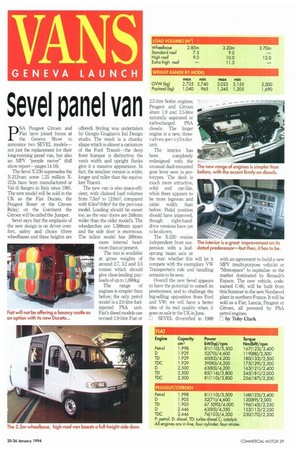Sevel panel van
Page 31

If you've noticed an error in this article please click here to report it so we can fix it.
pSA Peugeot Citroen and Fiat have joined forces at the Geneva Show to announce two SEVEL modelsnot just the replacement for their long-running panel van, but also an MPV "people move?' (full show report-pages 14-16),
The Sevel X-230 supersedes the X-212van: some 125 million X212s have been manufactured at Val di Sangro in Italy since 1981. The new model will be sold in the UK as the Fiat Ducat°, the Peugeot Boxer or the Citroen Relay; on the Continent the Citroen will be called the Jumper.
Sevel says that the emphasis of the new design is on driver comfort, safety and choice (three wheelbases and three heights are
offered). Styling was undertaken by Giorgio Giugiaro's Ital Design studio. The result is a chunky shape which is almost a caricature of the Ford Transit-the deep front bumper is distinctive; the van's width and upright flanks give it a massive appearance. In fact, the smallest version is wider, longer and taller than the equivalent Transit.
The new van is also space-efficient, with claimed load volumes from 7.5m3 to 12.0m3, compared with 65m3-9.8m3 for the previous model. Loading should be easier too, as the rear doors are 248mm wider than the older model's The wheelarches are 1,388mm apart and the side door is enormous. The tallest model has 280mm more internal headroom than at present
The van is available at gross weights of around 2.7, 3.2 and 3.5 tonnes which should give class-leading payloads of up to 1,690kg.
The range of engines is simpler than before; the only petrol model is a 2.0-litre fuelinjected PSA unit. Fiat's diesel models use revised 1.9-litre Fiat or
2.5-litre Sofim engines; Peugeot and Citroen share 1.9 and 2.5-litre naturally aspirated or turbocharged PSA diesels. The larger engine is a new, threevalves-per-cylinder unit The interior has been completely redesigned with the unusual dash-mounted gear lever seen in prototypes. The dash is much more attractive, solid and car.like, while there appears to be more legroom and cabin width than before. Pedal position should have improved, though right-handdrive versions have yet to be shown.
The X-230 retains independent front suspension with a leafsprung beam axle at the rear: whether this will let it compete with the exemplary VW Transporter's ride and handling remains to be seen.
Overall the new Sevel appears to have the potential to outsell its predecessor, and to challenge the big-selling opposition from Ford and VW; we will have a better idea of its real quality when it goes on sale in the UK in June.
E SEVEL diversified in 1988 with an agreement to build a new MPV (multi-purpose vehicle) or "Monospace" to capitalise on the market dominated by Renault's Espace. The new vehicle, codenamed U-60, will be built from this Summer in the new Nordsevel plant in northern France. It will be sold as a Fiat, Lancia, Peugeot or Citroen, all powered by PSA petrol engines.
E by Toby Clark




















































































